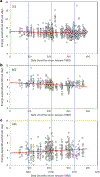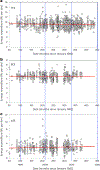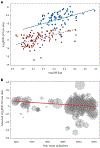Total daily energy expenditure has declined over the past three decades due to declining basal expenditure, not reduced activity expenditure
- PMID: 37100994
- PMCID: PMC10445668
- DOI: 10.1038/s42255-023-00782-2
Total daily energy expenditure has declined over the past three decades due to declining basal expenditure, not reduced activity expenditure
Abstract
Obesity is caused by a prolonged positive energy balance1,2. Whether reduced energy expenditure stemming from reduced activity levels contributes is debated3,4. Here we show that in both sexes, total energy expenditure (TEE) adjusted for body composition and age declined since the late 1980s, while adjusted activity energy expenditure increased over time. We use the International Atomic Energy Agency Doubly Labelled Water database on energy expenditure of adults in the United States and Europe (n = 4,799) to explore patterns in total (TEE: n = 4,799), basal (BEE: n = 1,432) and physical activity energy expenditure (n = 1,432) over time. In males, adjusted BEE decreased significantly, but in females this did not reach significance. A larger dataset of basal metabolic rate (equivalent to BEE) measurements of 9,912 adults across 163 studies spanning 100 years replicates the decline in BEE in both sexes. We conclude that increasing obesity in the United States/Europe has probably not been fuelled by reduced physical activity leading to lowered TEE. We identify here a decline in adjusted BEE as a previously unrecognized factor.
© 2023. The Author(s), under exclusive licence to Springer Nature Limited.
Conflict of interest statement
Conflict of interest
The authors have no conflicts of interest to declare.
Figures




Comment in
-
Human basal metabolic rate has declined over the past 30 years.Nat Metab. 2023 Apr;5(4):544-545. doi: 10.1038/s42255-023-00790-2. Nat Metab. 2023. PMID: 37100998 No abstract available.
References
-
- Swinburn BA, Sacks G, Hall KD, McPherson K, Finegood DT, Moodie ML and Gortmaker SL (2011) Obesity 1: the global pandemic.: shaped by global drivers and local environments. Lancet 378: 804–14. - PubMed
Publication types
MeSH terms
Grants and funding
- UL1 TR002369/TR/NCATS NIH HHS/United States
- P30 DK072476/DK/NIDDK NIH HHS/United States
- P30 DK056341/DK/NIDDK NIH HHS/United States
- K01 DK109079/DK/NIDDK NIH HHS/United States
- ZIA HD000641/ImNIH/Intramural NIH HHS/United States
- R01 DK090489/DK/NIDDK NIH HHS/United States
- MC_UU_00006/4/MRC_/Medical Research Council/United Kingdom
- Z99 HD999999/ImNIH/Intramural NIH HHS/United States
- R01 CA119171/CA/NCI NIH HHS/United States
- R01 DK126447/DK/NIDDK NIH HHS/United States
- WT_/Wellcome Trust/United Kingdom
- R03 DK122189/DK/NIDDK NIH HHS/United States

